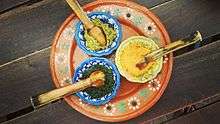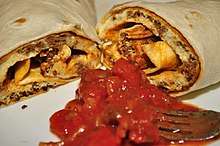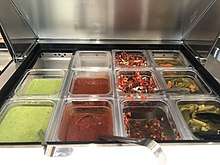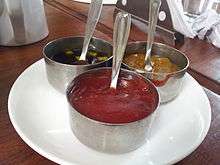Salsa (sauce)
Salsa is a variety of sauces used at table as condiments for tacos and other Mexican and Mexican-American foods, and as dips for tortilla chips. They may be raw or cooked, and are generally served at room temperature.[1]
 A variety of salsas | |
| Type | Condiment |
|---|---|
| Region or state | Spain, Catalonia, Mexico, Venezuela |
| Main ingredients | Varies |
Though the word salsa is Spanish for any kind of sauce, in English, it refers specifically to these Mexican table sauces, especially to the chunky tomato-and-chili-based pico de gallo, as well as to salsa verde.
Tortilla chips with salsa are a ubiquitous appetizer in Mexican-American restaurants, but not in Mexico itself.[2]
Diana Kennedy, The Cuisines of Mexico[3]
Salsa has found its way into some regional Jewish cuisines, for example Syrian Jews have combined the traditional dish kipe with salsa verde.[4]
Types
.jpg)

Mexican salsas were traditionally produced using the mortar and pestle-like molcajete, although blenders are now used. Mexican salsas include:
- Salsa roja, one of the two most common and well known types of salsa, "red sauce", is used as a condiment in Mexican and Southwestern (U.S.) cuisines; usually includes cooked tomatoes, chili peppers, onion, garlic, and fresh cilantro (coriander).
- Salsa cruda, "raw sauce", is an uncooked mixture of chopped tomatoes, onions, jalapeño chilies, and cilantro.[5]
Prepared salsa
While some salsa fans do not consider jarred products to be real salsa cruda, their widespread availability and long shelf life have been credited with much of salsa's enormous popularity in states outside the southwest, especially in areas where salsa is not a traditional part of the cuisine. In 1992, the dollar value of salsa sales in the United States exceeded those of tomato ketchup.[6]
Importance of proper storage

The World Health Organization says care should be taken in the preparation and storage of salsas and any other types of sauces, since many raw-served varieties can act as growth media for potentially dangerous bacteria, especially when unrefrigerated.[7]
In 2002 a study by the University of Texas–Houston, found sauces contaminated with E. coli in:
- 66% of the sauces from restaurants tested in Guadalajara, Jalisco, Mexico
- 40% of those from restaurants tested in Houston, Texas[8]
In 2010 the CDC reported that 1 in 25 foodborne illnesses between 1998 and 2008 was traced back to restaurant sauces (carelessly prepared or stored).[9]
A 2010 paper on salsa food hygiene described refrigeration as "the key" to safe sauces. This study also found that fresh lime juice and fresh garlic (but not powdered garlic) would prevent the growth of Salmonella.[10]
See also
References
- Sharon Hudgins, "Salsa" in Andrew F. Smith, ed., Oxford Companion to American Food and Drink, 2009, ISBN 0195387090, p. 517
- David Kamp, The United States of Arugula, 2006, ISBN 0767915798, p. 310
- Diana Kennedy, The Cuisines of Mexico, 1972, ISBN 0060123443, p. 296
- Taste, Politics, and Identities in Mexican Food. Bloomsbury Publishing. 2019. p. 181.
- "salsa cruda - food". Encyclopædia Britannica.
- "Ketchup? Catsup? Ke-cap? / Whatever the name, a squirt of red can change everything". SFGate.
- Larry R. Beuchat. "Surface decontamination of fruits and vegetables eaten raw: a review" (PDF). World Health Organization. Archived from the original (PDF) on April 5, 2011. Retrieved July 22, 2010.
- Javier A. Adachi, John J. Mathewson, Zhi-Dong Jiang, Charles D. Ericsson, and Herbert L. DuPont. Annals of Internal Medicine, June 2002, Vol. 136, pp. 884–887.
- "Salsa and Guacamole Increasingly Important Causes of Foodborne Disease". Retrieved July 23, 2010.
- Ma L; Zhang G; Gerner-Smidt P; Tauxe RV; Doyle MP (March 2010). "Survival and growth of Salmonella in salsa and related ingredients". J. Food Prot. 73 (3): 434–44. PMID 20202327.
External links
| Wikimedia Commons has media related to Salsa (sauce). |
| Wikibooks Cookbook has a recipe/module on |



.jpg)
